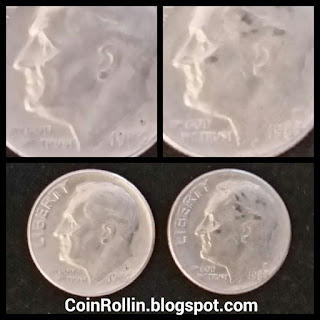We have had quite the adventure exploring our birthday coin collection.
Let's see how we are doing on our list...
1983 D - Quarter
1983 D - Half Dollar
Today, we will be searching three rolls of quarters for a 1983 D Washington Quarter!
Pick a roll to search:
Roll 1: Customer-Wrapped Roll
Roll 2: Bank-Wrapped Roll
Roll 3: Bank-Wrapped Roll
I hope you like the new coin roll hunting set up.
Now you're in control of the coin roll hunting experience.
Comment below to let me know what you thing.
Now, on to our find!
When you first encounter a new coin, it's important to learn some basic numismatic information.
Ask yourself these 5 simple questions:
1) What type of coin is this?
By looking at the reverse side, we can see the phrase "Quarter Dollar" below the image of the eagle. Sure, this all seems very basic, but it's also very important. Out of all the coins this could be, we have now narrowed it down to one very specific group.
Now we know that we have a quarter. Not a penny, a nickel or a dime, but, a quarter.
So, let's get specific.
2) What type of Quarter is this?
This question may seem a bit confusing at first, as you might not have realized that the quarter, as we know it today, used to look very different.
This is a great time to reference our guide book:
A Guide Book of United States Coins: The Official Red Book
With our guide book at hand, turn to the section about quarters.
Here you will see all the different designs that the quarter has had in the past.
One way to narrow down our search for what type of quarter we have is to look at the date on the obverse side of our coin.
This one reads, 1983.
Now, look up the date, 1983 in the quarter section of our guidebook.
Follow the dates backward with your finger, 1982, 1981, 1980, keep going until you reach the design header. It will read, "WASHINGTON (1932 TO DATE)"
Here you will see why we call this type of quarter a "Washington Quarter."
In 1932 the design of Standing Liberty was replaced by a portrait of the first President of the United States of America, George Washington.
Now we know we have a Washington Quarter!
3) Which mint produced our 1983 Washington Quarter?
We have already had some practice looking for mint marks. So, you will know what type of mint marks to look for and what each one will indicate.
Bring out your magnifying glass.
Closely examine the obverse side of our Washington Quarter.
Did you find it?
You will spot the mint mark just behind his neck.
The coin in this example shows a "D".
Now we know that our 1983 D Washington Quarter was minted at the Denver Mint in Colorado!
4) What is the composition of our coin?
We have already explored the composition of nickels and searched for silver in dimes. So, you might already realize that coins can be made of many different types of metals.
So, what is our Washington Quarter made of?
Once again, we will refer to our guide book.
You will notice that in the description for the first Washington Quarter, you will see that the coins from 1932 to 1964 were composed of 90% silver and 10% copper. You may have already heard these coins called, "Silver Quarters". This is because of their silver content.
Now, run your finger down the list of dates to 1965.
What happened on that date?
Our guide book tells us that the composition of the Washington Quarter was changed! Instead of using silver, they replaced it with a less expensive metal; nickel. But, it's more interesting than that!
By sandwiching a core layer of 75% copper between two thin layers of 25% nickel, the cost to produce a quarter went down. This method produces what we call a "clad" coin.
Clad coins are easily identifiable by the band of copper exposed in the edges of a coin.
Let's take a look at the edge of our 1983 D Washington Quarter.
See that band of copper in the edge?
That is the easiest way to tell if you have a clad coin.
Now we know that our 1983 D Washington Quarter is clad, and composed of 75% copper and 25% nickel.
5) How many coins of this type were made?
To answer this question, simply slide your finger forward through the dates to find 1983D again. Now, follow the dotted line to the right.......to find a number under the column "Mintage".
Mintage refers to the quantity of a coin that was produced at a specific mint for a specific year.
Following the dotted line for 1983D, we see that the Denver Mint produced 617,806,446 coins!
AMAZING!!!
We now have in our possession, 1 out of 617,806,446 coins! Another one will never be made and coins of this date will continue to be lost, damaged and destroyed, every day of every year; never to be seen again.
That's why it is so important for us to take great care of our coins.
By becoming a numismatist, you must also become a curator for your collection. Make sure to wear gloves when handling your coins and store them in a dry location.
From this moment on, you are responsible for a piece of history that can never be replaced.
We will go further into storing and displaying our coins in a future blog. But, for now, let's just enjoy our find!
Subscribe to my YouTube Channel to see other videos and playlists not included in this blog.
And, keep growing your numismatic knowledge with these great books!
1) Handbook of United States Coins: Official Blue Book
2) A Guide Book of Washington and State Quarters: Complete Source of History, Grading, and Prices
Until next time,
Happy Hunting!







